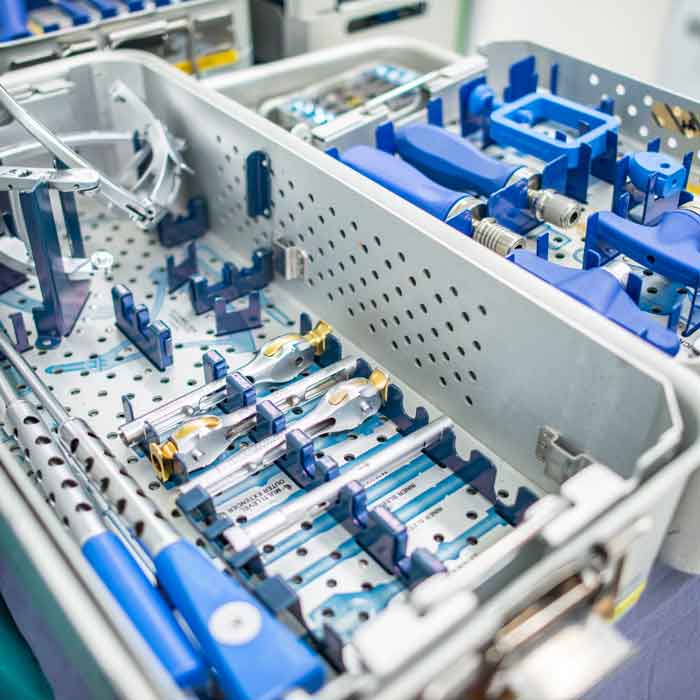
Plastics machining and plastics fabrication are terms sometimes used interchangeably when referring to ways to make components for medical devices and equipment. Most probably this is because “fabrication” by its simplest definition implies making something.
Within the plastics manufacturing industry, however, the two terms refer to distinctly different techniques for working with thermoplastic materials. The desired end products are much different. Also, companies who define themselves as plastics machine shops have much different equipment and operations set-ups from those who identify themselves as plastics fabricators. The typical short versions are “machine shop” and “fab shop.”
The metals industry serves as a good analogy. Machine shops turn metal bar stock and plate into parts, screws and the like. Fab shops cut, bend, punch and assemble or fabricate sheet metal into things like equipment covers.
Are Material Forms Different for Plastics Machining vs. Fabrication?
This is an area where the two production methods vary widely. As with the metals industry, starting materials are completely different, as is the production equipment needed to produce the components.
Plastics Machining Starts with Extruded Stock Shapes.
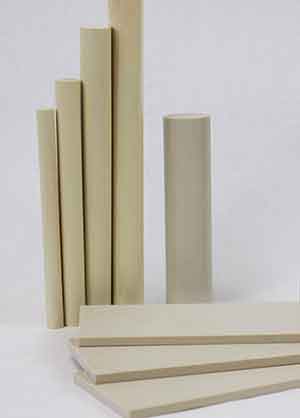
Plastics machining uses extruded stock shapes to produce a finished component. Thermoplastic shapes such as those used to machine medical device components are produced by extrusion. An extruder melts the polymer pellets, and an internal screw pushes the molten material through a die that imparts the desired shape.
These shapes are in the form of rods in a range of diameters and lengths, and plates in many different widths, lengths and thicknesses. Another material form is rigid tube, also termed tubular bar. Rigid tube works well for machining components with a round, hollow configuration, such as a seal ring. It minimizes material waste where the center would be milled out if solid rod were used. Some specialized thermoplastics extrusion companies make rigid tube in a wide range of inside and outside diameter combinations.
Plastics Fabrication Generally Involves Extruded Thermoplastic Sheet.
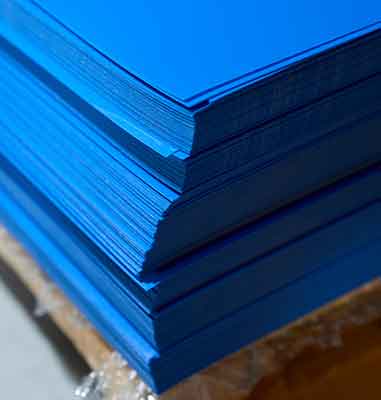
Plastics fabrication most commonly uses rigid sheets of thermoplastic as the starting material form. Thermoplastics such as medical grade polymers are converted into sheets by extrusion. Typical sizes of medical grade thermoplastic sheets are 4 feet (1.2 M) wide by 8 ft. (2.4 M) long.
While the basic melt processes for producing shapes and sheets have similarities, they end at the die. At that point, the melted thermoplastic takes its final form. Sheet extrusion also converts far higher volumes of thermoplastic material in each production run.
Polymers used to extrude sheet materials can be clear or opaque. Pigments are often blended into the polymer for custom colored sheet. Patterned extruder rolls can impart a texture or decorative pattern on the surface before the sheet solidifies. For transparent applications in the healthcare industry, medical grades of clear and translucent acrylic and polycarbonate sheets are common.
How Do Production Methods Differ Between Machining and Fabrication?
While some production operations are similar, machining and fabrication involve distinctly different shop floor equipment and methods for producing the desired components.
Machining Operations
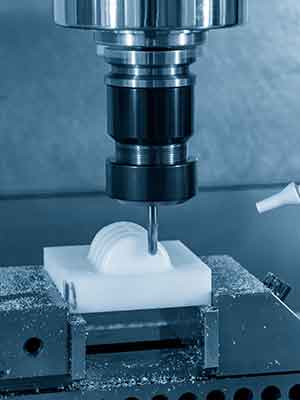
For complex medical device components, for example, common machining operations include milling rod and plate with sharp tools like router bits, turning stock shapes on lathes, and drilling. All involve cutting away some of the plastic material from a rod or plate to produce the desired configuration to design specifications. While “cutting” may sound like a crude process, the technology is complex and has advanced significantly. The finished part quality, precision dimensions and consistency that machining achieves are excellent and easily satisfy the high standards of the medical device industry.
Today’s CNC (computer numeric control) equipment illustrates a key development in this production method. CNC machining saves set-up time and yields components to exact dimensions consistently from one production cycle to the next. Equipment operators are typically programmers. Once they set up a program for machining a specific component, the same programming is called up for each successive run. CNC machining achieves the exact component design time after time, an essential for medical device quality standards in particular.
Tooling technology for machining has also undergone significant improvements. For example, five-axis CNC machine tools rapidly mill or drill into a plastic stock shape from several different angles. The tooling quickly turns out medical device components with highly complex design features and functionality in a single machining cycle.
In the medical device industry, machining affords cost-effective prototypes. It is also ideal for lower production volumes for market testing and in the early life cycle of a device. As quantity requirements grow, manufacturers usually turn to injection molding. The trigger point comes with the quantity level that justifies an investment in production scale injection molding tooling. The savings in material utilization offset the investment cost. Molding also affords faster production times, and several parts can be produced at once in multi-cavity tools.
Fabricating Plastic Sheet
Plastic fabrication starts with a full size sheet of thermoplastic. The sheet is then cut-to-size. Most plastics distributors perform this service. For high quantity applications, computerized saws cut stacks of sheets into precise “blank” sizes at very high speeds.
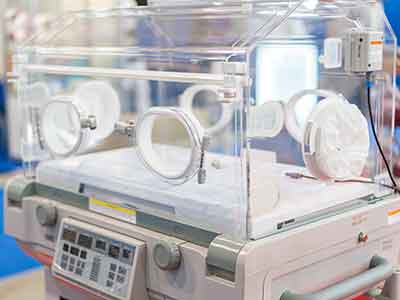
Fabricated applications often involve just a few simple production steps. These can include saw cutting or routing the edges of the blank, heating and bending it to a desired angle, and drilling to add attachments. Some applications also require solvent or heat polished edges for aesthetics. Different pieces are fabricated using solvents, glues, adhesives, tapes or mechanical fasteners for final assembly.
Medical equipment applications such as trays and equipment housings are formed and fabricated from sheet in a more complex process known as thermoforming or vacuum forming. Full sheets or cut blanks are brought to a softening temperature and placed on a heated mold that duplicates the desired configuration. Forming can occur under pressure from a top mold, or by applying a vacuum that pulls the sheet tightly onto the heated mold. The formed pieces are then trimmed with routers or saws. Functional hardware might be added. They are then assembled onto the equipment or combined with other fabricated pieces to complete fabrication of the entire unit.
How Do Applications Differ for Machined vs. Fabricated Medical Plastics?
Machining and fabrication produce very different components for medical devices and equipment. For the most part, the applications are closely related to the capabilities of each production method. And while both utilize many of the same medical grade polymers, certain thermoplastics are more broadly associated with either shapes machining or sheet fabrication.
Machined Medical Plastic Components are Complex and Have Stringent Biocompatibility Requirements.
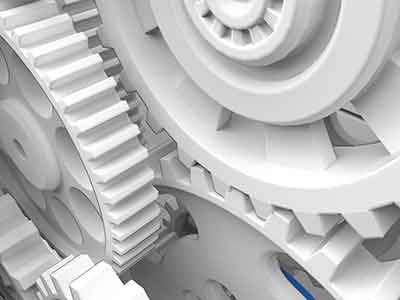
Components machined from medical grade plastics such as PEEK, Radel PPSU and Ultem PEI tend to have complex configurations and a high degree of functionality. They often require high strength and high dimensional stability in their application environment. Some also must meet stringent biocompatibility standards compared to fabricated sheet applications. Machined Radel and acetal, for example, are machined into different colored sizing trials that see short term internal contact in joint replacement surgery.
Implantable PEEK applications are on the rise. Machining can be the starting point for a PEEK device’s life cycle until quantity requirements build to levels justifying injection molding.
Functional components like valve bodies for medical equipment are also ideal candidates for machining because of their intricate features and configurations. Often, they must comply with healthcare industry standards for conveying various fluids and medications.
Medical grade plastics for these applications require some level of resistance to various sterilization methods. High performance biocompatible polymers such as PEEK, Radel and Ultem are often chosen for the superior life they afford components used in these environments.
Medical Grade Thermoplastic Sheet Products Provide Durability and Aesthetics for Trays, Carriers and Equipment Covers.
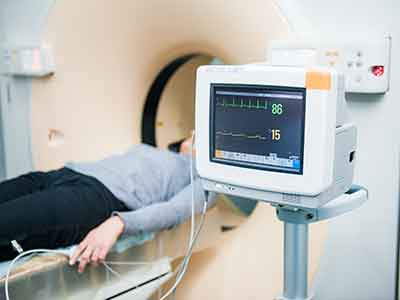
Most medical equipment incorporates covers made from small and large formed sheets of various materials. The range of applications spans everything from large diagnostic machines to newborn incubators. In sheet form, polymer materials such as Radel PPSU, Ultem PEI, ABS and acrylic differ in their properties. Each serves different requirements that applications have for toughness and durability, cleanability, and resistance to a range of operating temperatures.
Aesthetics play a key role in medical equipment, and one that medical plastics in sheet form easily satisfy. Acrylic, for example, offers a range of gloss levels from crystal clear to translucent matte. Opaque polymers like ABS, Radel and Ultem offer unlimited custom colors for sheet products that conform to the corporate image of the equipment manufacturers.
Common Advantages
Medical grade plastics, whether machined or fabricated, afford the healthcare industry many advantages over metals. Components, covers, and instruments have lighter weight. They resist denting and permanent damage in the rigors of the hospital environment. They last through repeated sterilization and cleaning cycles. Their color range and textures enhance the patient’s aesthetic environment. And their biocompatibility now extends to implantable devices.
These attributes stem from continued investments in polymer technology to better serve the needs of the healthcare industry, whether by machining or fabrication.
